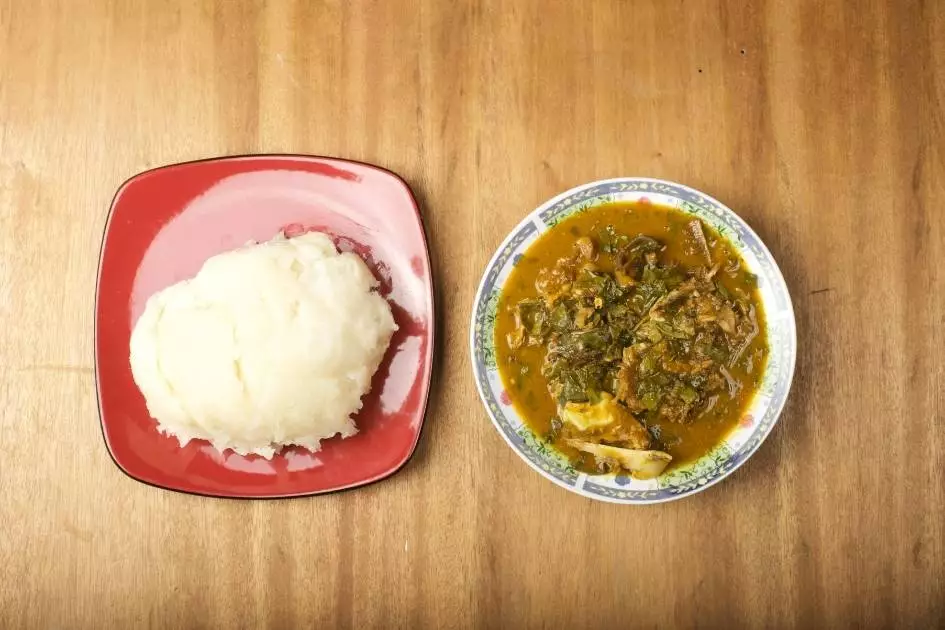Fufu is a popular West African dish made from boiled or steamed cassava, plantains, yams, cocoyam, or other starchy vegetables. Fufu is often eaten with beans and sauces. You can also use fufu as an ingredient in soups and stews. It can be served hot or cold depending on the occasion and the preference of those eating it.
Fufu is usually prepared by boiling tuber-like cassava (also known as manioc) until it becomes soft enough to mash into a dough-like consistency. You can use either your hands or a mortar and pestle, then adding salt for a taste before cooking over low heat until all the water has evaporated off. Plantain fufu is boiled or steamed and mashed. Yams, cocoyam, and other starchy vegetables are also used to make fufu.
The process of making plantain fufu is similar but requires a higher level of skill due to the thickness of the tuber's skin which must be peeled before boiling for it to become soft enough to be mashed.
There are many versions of fufu, the most popular being Nigerian, Ghanaian, and Sierra Leonean. In addition, the dish is there in other countries like Senegal, Liberia, and Congo. In Nigeria, they often serve fufu with a red-pepper sauce or palm oil (Nigerians call this dish "wansa"). In Ghana, it's typically served with pepper soup, while in Sierra Leone, it might also be a part of the main course of an ethnic dinner.
As mentioned earlier, fufu often goes with various sauces and beans, but people can also use it to make soups or stews. In Nigeria, for example, okra stew might include plantain fufu, while in Ghana, the bean soup has cocoyam fufu mixed into either red-pepper sauce or palm oil.
How to Store Fufu
It's essential to store fufu in the refrigerator to prevent it from spoiling. You can also freeze some of your leftover fufu for a long-term option., as well.
To store fresh or cooked fufu, transfer into rigid containers and seal airtight with a lid.
If you want to keep your leftovers refrigerated and heated without spoilers, please place an open container filled with cold water next to the stored fufu to maintain its temperature while preventing any new bacteria from growing on top of it. If frozen, wrap tightly using freezer paper and label clearly before storing so that no one mistakes it for today's dinner! Serve at room temperature (i.e., not reheating) by transferring the fufu to a bowl and then microwaving for just one minute.
How to Reheat Fufu in Microwave
- Place in microwave (single-serve) container with cover or transfer into a separate serving dish, add the desired amount of water, place in oven on low heat for 5 minutes or until heated. Water is to prevent scorching on the bottom of the dish. But it's optional as soon as you watch the progress of reheating.
- Transfer onto a plate and wrap tightly using aluminum foil before placing over high heat stove burner; discard once warmed.
Remember that you can always purchase frozen or refrigerated packages of fufu, which have already been processed at home, so all you'll need to do is defrost them! It's best not to return cooked food back into its original packaging if it was previously opened as bacteria may be present from the air.
How to Reheat Fufu on Stove
You can also reheat fufu on the stove. Simply place the desired amount of water in a pot and then transfer heated (or raw) fufu into it to simmer, stirring occasionally. It should take about 5-10 minutes for the dish to heat up completely before serving.
When ready to serve, pour into the bowl and add desired sauce or oil according to your choice.
How to Reheat Fufu in Oven
It's similar to the microwave option we talked about above, but you'll need to transfer the fufu into an oven-proof dish or pan and heat it at 350 degrees Fahrenheit for 30 minutes. Since ovens may vary in terms of temperature, it's best to monitor the dish so that there are no accidents or overcooked fufu.
You can also reheat fufu in an air fryer oven that includes reheat function. Specially air fryers with shelves, because you can easily place the bowl on top of the tray without burning your hand because of heat.

FAQ
Conclusion
If you're looking for an easy way to reheat your fufu, and don't mind the oven, then this is a good option. Even though it takes longer than the microwave or stovetop options, it's still worth considering because of how delicious it tastes! The choice is yours, but hopefully, one of these methods will work well for you.


